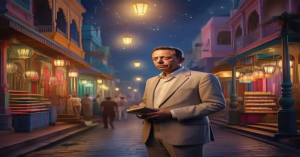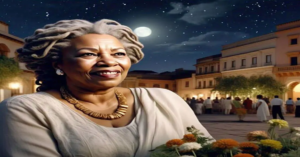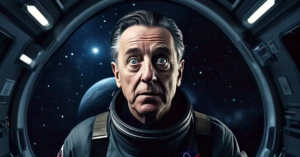Latest News
My latest ramblings.
Enjoy! I definitely got important things to say
My latest ramblings.
Enjoy! I definitely got important things to say

Albert Camus was a philosopher but also more than that.
A novelist, playwright, journalist and moral thinker, Dos Passos spent many decades defying popular modes of understanding the world.
Frequently lumped with the existentialists, Camus nevertheless forged his own path through 20th-century philosophy with a worldview based on the absurd.
At the heart of Camus’ philosophy is a simple, yet profound question:
When life feels meaningless, what do we do?
Through his forbidding, austere inquiry into the surreal absurdity of our human reality, and the absurdity of the larger universe that doesn’t seem to give a damn, between our longing for meaning and a silent universe that eats life for breakfast and keeps ticking, Camus offered no final answers, only the courage to make art — to make what you can and to keep living because one improvised act can make a difference.
It’s the nature of the Absurd.

Albert Camus was born on Nov. 7, 1913, in Mondovi, a town in French Algeria.When he was only 1, his father, who fought in World War I, was killed, and his destitute mother raised him.In spite of poverty, Camus did well in school and was accepted at the University of Algiers.He read philosophy with an emphasis on classical philosophy, ethics, and literature.
Bergman early on had to give up competitive sports when tuberculosis caused him to be sidelined and interrupted his education, but his early trials gave him an abiding sense of mortality and human frailty — qualities that would resonate in his work later.
The light of the Mediterranean, the landscapes of North Africa, the tensions of colonial life indelibly shaped his aesthetics.For Camus, nature was not just backdrop — it was essential to the comprehension of existence.
Camus was influenced by several streams of thought and political opinion.He was critical of authoritarianism and leery of dogmatism.Heomerë pashe u anëtua në Partinë Komuniste Franceze, por më vonë iu ankthye te ortodoksia marksiste duke mbështetur se revolucioni nuk duhët të justifikojë injuistësinë.
His World War II experiences, including his service with the French Resistance and his work as the editor of the underground newspaper Combat, confirmed his faith in individual responsibility, moral action and intellectual candor.
Camus refused easy answers.He did not believe in nihilism, but neither did he trust utopian solutions.This tension would be central to a lot of his work in philosophy.
Absurdism According to Camus, Absurdism is derived from the opposition of the human search for meaning and the universe that offers no meaning.Humanity’s quest for order, understanding and resolution
That indifference of the universe to our desiresThis collision — between a logical brain and a nonsensical world — is what gives rise to absurdity.In The Myth of Sisyphus (1942), his philosophical essay, Camus states:
“It is born of this confrontation between the human need and the unreasonable silence of the world.Absurdism is not a rejection of meaning, but an acknowledgement that meaning is not intrinsic and immutable.Life is absurd by this reckoning, but we move on anyway — staring into the void and realizing life has no distinct purpose, and make a life for ourselves in this absurdity.
Camus has often been lumped in with Sartre and Kierkegaard as an existentialist, but he refused the label vigorously.Existentialism is often about making your own meaning in a meaningless world.Camus, however, refused to make this leap on the grounds that doing so was disingenuous.
He thought that such enterprises were some form of philosophical suicide — comforting but false beliefs that turn away from the absurdity of life.Instead of manufacturing meaning, Camus argued for a life of perpetual revolt against the absurd — living in a state of acceptance of the absurd without submitting to it or succumbing to the dark side of nihilism.
The absurd hero, for Camus, doesn’t believe in salvation or answers.They love deeply and fully, and they do not hold out false hope.
Camus introduces the essay with the answer to the question, “What is the absurd?” in the opening sentence: “This book will explain the absurd” (Camus 3).The rest of the essay can interpret as an elaboration of this opening sentence. The essay is to Pascal Pia and is in four chapters and one appendix.
The gods damned to push a boulder up a hill forevermore, only for it to roll back down, Sisyphus is a model of the human experience.To Camus, the picture is not tragic — it’s liberating.
Sisyphus knows the end before it even begins, however, he still keeps working.That this conscious rebellion — the insistence on continuing in the face of futility — feels heroic is no coincidence.“One has to imagine Sisyphus happy,” Camus concludes.
Sisyphus finds his freedom in the embrace of the absurd.The myth is an allegory of contemporary life.Our routines, our relationships, and our aspirations may not have cosmic import, but they do find value in our recognition and election to live them.
For Camus, rebellion is key.And not just as a political act, but as a matter of philosophy.The rebel is the person who says “no” to injustice, meaninglessness and falsehood, and who doesn’t cozy up to any religion, ideology, or despairing fatalism.
Rebellion is living authentically.It’s not about winning.It’s not about negating absurdity so much as it is about refusing to be defeated by it.This idea runs through all of Camus’s work — in characters, in essays — and it is truly an aspect of his legacy.
The absurd in Camus’ The Stranger (L’Étranger, 1942) . So you can see the absurd through Camus’ character Meursault. In The Stranger — who is emotionally isolated from the rest of society.
Meursault’s detachment stuns readers — he doesn’t cry at his mother’s funeral, has relationships devoid of love, murders a man with no apparent reason.
His crime is not just the killing. But his refusal to abide by society’s emotional rules. In court, Meursault is put on trial less for his crime than for his lack of remorse. He’s excoriated for not lying — for declining to fake what other people want him to feel. Camus uses Meursault to meditate on the results of uncompromising honesty in an absurd universe.
The last realization of Meursault in prison is important. Here he takes the indifference of the universe and our own inescapable death as given. But instead, not despair but peace comes from this acceptance.
He regards life without illusions and what he sees is plain. And in that plainness he finds a sort of freedom. The novel doesn’t conclude with a vision of hope, but of bravery.
This, in a sense, is the absurd hero of Camus: not the man who so cowardly runs from death. But the one who faces it down with his eyes open.
Camus was a believer in the individual’s responsibility. So he risked his life by continuing to publish resistance journalism. During the Nazi occupation of France, in which the words fought tyranny.
Such action, for him, can never forsake human dignity. Then he rejected both fascism and Stalinism. And the notion that violence could justice in the name of an ideal. Freedom, for Camus, was not theoretical.
It was to live and personal and always under attack from dogma and fear. He preached the virtue of marital moderation. Then necessity for dialogue and the duty to summon the courage to resist injustice. When great profits promised for embracing it.
Camus was a moral realist. He rejected objective moral truths. But he was not a moral relativist either. That, instead, was the human-centered ethics. Here he advocated:One that treats people with dignity, reduces suffering, and promotes accountability.
His moral outlook was able to root in humility — knowing our bounds — and solidarity. Then need to take care of others who are in the same ridiculous boat. For Camus, doing good didn’t have to be grounded in faith in God or eternal justice.Only tt needed the courage to face the world as it was — and to act.
Camus’s thinking is more pertinent than ever. In a world crisis defined, climate anxiety, political extremism and rapid change, many feel drowned in uncertainty. He provides no counterfeit hope. But he gives something far more valuable:
Courage to live honestly, and strength to find meaning In the face of chaos. The point of absurdism is not that we should be happy. It asks us to be brave.
It reminds us that love, friendship and art and rebellion matter anyway — not because they’re eternal.But because we do them, that’s why.
Camus’s influence reaches well beyond the ivy-covered halls. His writings have influenced writers, filmmakers, musicians and activists. The Stranger and The Myth of Sisyphus also weave their way through the fabric of contemporary fiction, existential cinema, and, in some cases, the design of a game.
His style of prose — plain, lyrical, unadorned with affectation — would become a new norm in philosophical writing.His stand for honesty, humility and personal responsibility. Still lights the way for thinkers in search of meaning without illusions.
Albert Camus changed the face of modern philosophy. But not by giving us answers to our questions — instead, he left us better questions. He didn’t blink at death, meaninglessness, suffering — he said we must live anyway.
His Absurdism says no to despair and yes to living without lies. It calls on us to live fully, to resist injustice and to seek beauty that exists in the vanishing light. Camus is a rare figure, then — a thinker who reconciled philosophy and action, art and ethics.
In his lucidity, courage and kindness, he provides a life-line to living well in uncertain times.Not with grand solutions. But with unforgivable honesty and a level stare.At a moment when meaning seems frangible. Camus’ reminder that to live deliberately — eyes open, heart engaged — is itself a form of quiet rebellion feels more urgent than ever.

Chloe Ardelia Wofford, who became known as Toni Morrison, was born on Feb. 18, 1931, in Lorain, Ohio, a racially mixed industrial city to which her father had moved to take a welding job and where her mother was a homemaker and a part-time seamstress. Her family surrounded her with a deep-seated love of storytelling, folklore, and African-American folk culture.
Morrison’s father, George Wofford, regaled her with African American folktales and songs, which would later shape her literary mode. Her mother, Ramah Willis Wofford, also fostered a sense of academic excellence and artistic curiosity.
A talented student, Morrison went to Howard University in Washington, D.C., where she studied English as a major and minored in classics. It was in Howard that she adopted the name “Toni,” a shortened form of her baptismal name, Anthony.
She would later receive a Master of Arts in English from Cornell University in 1955. Her master’s thesis was about Virginia Woolf and William Faulkner — modernists who would exert a shaping effect on her own nonlinear, multivoiced narratives.
Her early years formed an acute awareness of race and gender dynamics that would equip her to challenge the literary status quo.
She later went on to teach English at Texas Southern University, and later Howard University, where she mentored future leaders and activists.
That grounding in education, tradition and intense thinking formed the scaffolding for her future as one of the most influential literary minds of the motley 20th century.
Morrison’s literary work was acknowledged, and celebrated, at the highest levels.
Her novel Beloved (1987), for which she won a Pulitzer Prize for Fiction, ranks among those highly regarded for depiction of African-American culture and history. The book had been inspired by the harrowing, true story of Margaret Garner, a slave who in 1856 fled one of her owners but was recaptured and who then killed her own child rather than see it returned to bondage.
The novel explored memory, trauma, silence and motherhood, and the conscious and subconscious mind, and was written in Morrison’s lyrical prose signature.
Then, in 1993, the Nobel Prize in Literature was awarded to Morrison — who became the first African American woman in history to be given the prize.
The Nobel Committee lauded her as one who “in novels characterized by visionary force and poetic import, gives life to an essential aspect of American reality.”
And the victory was not just personal: It was a breakthrough for Black literature around the world. Her victory affirmed the importance of telling previously marginalized stories in history and literature.
Toni Morrison frequently insisted that she did not write for storytelling, but for truth-telling.
She deployed literature to confront systemic injustices, re-write marginalized histories and present Black life as worthy of serious artistic attention.
Instead of making the Black experiences palatable for a white audience, she unapologetically wrote for Black readers — producing material that asserted identity, dignity and resistance.
Morrison had said, “I slipped into the border, stood at the edge, claimed it as central.”
Both texts challenged the boundaries of what could be seen as the center to the literary world — not just writing Black characters into traditional stories, but making stories entirely in the shape of Black consciousness.
She upset the standard gaze, refused to render her characters accessible through white lenses.
This was literature as cultural activism.
She also believed that language was a realm of oppression and liberation. Her careful language — layered, metaphoric, musical — underscored how words could free the mind and the memory.
Morrison’s works weren’t political slogans; they were profoundly human and fabulously crafted stories that had the force of cultural landmarks.
By narrating the inner lives of Black people, she demonstrated that it was possible for dignity to survive dehumanization.

It is her first novel, and it follows the story of Pecola Breedlove, a young Black girl who yearns for blue eyes.
Taking place in the Ohio of the 1940s, the novel deals with the notion of beauty standards, racial self-hatred and systemic abuse.
Morrison provides an unsparing critique of how media, society and, by extension, even family, can warp a child’s sense of their self-worth.
The novel has endured as a mainstay on high school and college reading lists — despite frequent challenges and bans over its unblinking depiction of sexual violence and racism.
It was this novel for which Morrison received national acclaim and the National Book Critics Circle Award.
It tells the story of Milkman Dead, a man searching to make sense of his family’s history and of himself. The book is an investigation of ancestry, legacy and the quest for meaning in a fractured world.
Loosely based on the myth of Song of Solomon combines realistic narration with African-American folklore, and the oral tradition is one of her most structurally experimental works.
Beloved (1987)
Arguably Morrison’s masterpiece, Beloved studies the high price of slavery as Sethe, a former slave is haunted by the ghost of her dead child.
Memory and trauma, sacrifice and the redemption of the supernatural all abound beneath the surface.
Morrison’s shattered timelines are the perfect allegory for shattering trauma and identity.
The novel is emotionally high-pitched, structurally intricate and ethically challenging — in other words, everything you could want it to be if you’re someone who reads to be related to in the most profound way possible.
Other Notable Works:
All her novels are acts of textual resistance and meditation on history.
Morrison’s literature did not marginalize black identity — it was central. She bucked stereotypes, instead crafting characters who were complex, flawed, smart and strong. They were not stand-ins for ideas or issues — they were complete people.
Her work unpacked:
For example, in Sula (1973), she examines female friendship and social deviance in a small Black community. Sula Peace herself, as a character, defies every norm — revealing how Black women negotiate society’s expectations and punishment.
In Paradise” (1997), Morrison examines how even utopian Black communities can marginalize and oppress women. Morrison made it clear that liberation was not only political, it was also psychological and cultural. She had frequently written about the friction between individual freedom and the constraints of community.
Her writing underscored that Black people were not simply stereotypes or victims, but a people of resilience, creativity and humanity.
Toni Morrison’s style is unmistakable.
She employed non-linear structure, stream-of-consciousness and multiple perspectives to convey the complexity of Black experience.
She wrote rhythmically, inspired by African American oral traditions, gospel, jazz and blues.
She made biblical and mythic allusions while also rooting her stories firmly in what Beck calls lived realities.
Morrison mirrors psychic trauma with silence and fragmentation in Beloved.
The narrative unfurls in layers, through the voices of the living and the dead.
In Jazz she follows the jazz music’s spirit of improvisation- unpredictable and circular, but still as one.
She was also a hider and an omitter.
What characters don’t say — or can’t say — says volumes. Morrison asked her readers to hear the silences, the unspeakables, the emotionally fraught absences.
Her work was not to be passively consumed.
It required close reading, emotional involvement and ethical consideration
Morrison previously worked as a senior editor at Random House from 1967 to 1983, before her literary fame.
She paved the way for Black writers, publishing seminal works such as:
The Autobiography of Angela Davis
The Black Book: An Anthology of Black History
Books by Toni Cade Bambara, Gayl Jones and Muhammad Ali
She leveraged that position not just to amplify voices but to change the industry’s focus.
In an era when publishers routinely ignored or tokenized Black voices, Morrison made sure to make them impossible to ignore.
Her editorial work helped extend the cultural footprint of Black literature and political thought.
Toni Morrison’s interviews, speeches and essays are often quoted — they compact insight into that hard, sharp nugget of phrase. “The purpose of freedom is to free someone else.”
“If you have power and you don’t have the ability to be empathetic, then it’s dangerous.” “Definitions reside with the definers, not the defined.” Power up and speak out with these empowering activist mantras.
Her nonfiction collections, such as Playing in the Dark (1992) and The Origin of Others (2017), censure how whiteness and Blackness have been made in literature. She scrutinized how white American literature had used Blackness as a foil to define itself — and called for a shift in the literary imagination.
During her time as an educator at Princeton University from 1989 to 2006, Morrison showed great care and rigor in mentoring young writers.
Also she founded the Princeton Atelier, a program that gathered artists in different fields to explore creativity in novel ways.
Writers such as:
each of whom have cited Morrison as a seminal influence. Continuously, she taught them to write bold narratives, not to wait for permission — to demand the power to make their lives on the page.
Her public talks and appearances often spoke not only to national crises — over education, over racism, over war — but also to how she personally was made to sound mute. Merely she made clear, calm forceful argument an incentive to think harder, not to feel more. Even at political times, Morrison remained engaged with the ethics of storytelling, avoiding slogans in favour of layered truths.
The influence of Toni Morrison extends well beyond literature. Altered she the way we think about race, memory and identity. So she shifted how institutions teach literature, how critics evaluate cultural worth and how writers build stories.
Her work is read around the world. Papers are held by Princeton.That documentary Toni Morrison: The Pieces I Am still brings her to younger generations.And she continues to live on in movements such as:#BlackLivesMatter: base where her words inspire resistance and healing.
Diversity in Publishing: A Younger Generation of Writers “You have to be really good” above and beyond her editorial legacy to triumph over gatekeepers.Here Black Women Writers’ Renaissance: An era she helped to both spark and maintain.Merely Toni Morrison didn’t give voice to the voiceless.So she demonstrated that they had been talking all along — and demanded that the world finally listen.
Not of literature’s irrelevance, Morrison’s career is evidence. But of its power to:into each to:to make and break entire cultures. With moral clarity, she wrote with purpose, edited with honor, spoke.
Her life’s work is a travel guide for any writer who wants to write honestly in a world that frequently values silence; who wants to interrogate their own prejudices and assumptions. So she demonstrated that language could be a terrain of struggle, remembrance and liberation.
And her legions of adoring followers, myself included, were faced with the prospect of a world in which there would be no new great book titles about DeCamp.

Nietzsche once declared Fyodor Dostoevsky the only psychologist he had anything to learn from, thanks to his psychologically profound novels. A closer look at Crime and Punishment or The Brothers Karamazov reveals more than just fiction. These works offer a masterclass in human psychology that predicted concepts which would only be formalized decades later.
Fyodor Mikhailovich Dostoevsky’s exploration of psychological repression became the foundation for psychoanalysis. Freud’s praise was telling – he called The Brothers Karamazov “the most masterly novel ever written.”His broader work serves as a big experimental canvas where he continuously explores the problem of selfhood.
Let me take you through the hidden psychological dimensions that make Dostoevsky’s novels revolutionary psychological studies. These works are not just literary masterpieces – they continue to appeal to our understanding of the human mind today.
Exploring deeply into a Dostoevsky novel brings you face to face with characters who surpass typical literary boundaries. His creations breathe, suffer, and contradict themselves with stunning psychological authenticity, unlike the flat personalities in most 19th-century fiction. These qualities are the foundations of his lasting literary legacy.
Dostoevsky’s characters come alive in remarkable ways. They embody psychological contradictions that mirror our own inner battles. His main characters hold conflicting desires, thoughts, and motivations at the same time—just like real people do. Take Prince Myshkin from The Idiot. His compassionate nature clashes with his social awkwardness, which makes him feel genuine despite his extreme qualities.
The author broke new ground by using inner monolog to show his characters’ psychological states. He doesn’t just describe what they do—he takes readers deep into their turbulent minds. This creates a unique closeness between reader and character. We don’t just watch Raskolnikov pace his cramped room in Crime and Punishment—we feel his anxiety right there with him.
Dostoevsky’s characters grow through psychological crisis, not convenient plot twists. Their changes come from deep internal battles. Dmitri Karamazov’s path from pleasure-seeking to spiritual awakening happens through psychological torment rather than outside events. This makes their development feel natural rather than forced by the story.
The author also refused to put characters in simple moral boxes. They aren’t heroes or villains but complex people capable of both greatness and darkness—often at the same time. All but one of his most despicable characters show some good qualities, while his most virtuous ones fight dark urges. This moral complexity shows the author’s grasp of human nature’s resistance to easy labels.
Psychological trauma runs deep in Dostoevsky’s characters, giving them unusual depth for his time. Stavrogin’s confession in Demons reveals childhood wounds behind his adult actions. Sonia in Crime and Punishment shows inner strength despite deep suffering. This focus on why things happen makes their actions believable, no matter how extreme.
The author expressed psychological concepts decades before they became formal theories. His natural understanding of human psychology pointed the way for multiple schools of psychological thought.
Dostoevsky saw Freudian psychoanalysis coming through his exploration of hidden motives and psychological repression. The Underground Man’s self-destructive behavior, despite knowing better, shows what Freud later said about unconscious drives. On top of that, he understood dreams’ psychological importance long before Freud’s The Interpretation of Dreams. Raskolnikov’s nightmares reveal mental states he pushes down, opening windows into his unconscious mind.
His work laid the groundwork for existential psychology. Cognitive dissonance theory appears throughout his novels. Raskolnikov breaks down in part because his intellectual reasons for murder clash with his moral instincts. Leon Festinger didn’t formally identify this psychological mechanism until the 1950s.
These insights stand out because they came from watching and understanding people, not scientific study. He lived inside his characters so completely that their psychological reality jumps off the page. Modern readers find not just gripping stories but psychological truths that feel surprisingly current.
Dostoevsky’s psychological depth comes from his belief that humans are incredibly complex. Instead of simplifying this complexity to make the story easier, he embraced it. He created characters whose psychological truth continues to appeal across centuries and cultures.

Dostoevsky shows us how intellectual pride, mental anguish, and spiritual rebirth connect through this troubled character.
Raskolnikov’s psychology centers on his controversial theory that splits humanity into two groups: ordinary and extraordinary people. His framework states that “ordinary people have to live in submission and have no right to transgress the law, because they are ordinary.” The extraordinary ones, however, “have the right to commit any crime and to transgress the law in any way, just because they are extraordinary.”
Raskolnikov believes exceptional individuals like Napoleon have an “inner right” to cross moral lines if it serves a greater purpose. These remarkable people might do terrible things, yet their actions become justified because they move civilization forward. They “sanction bloodshed in the name of conscience.”
This theory reflects how desperately Raskolnikov needs to feel important. He dropped out of university and fell into poverty. These failures led him to seek validation through his philosophical ideas. He tests if he belongs among the extraordinary to lift himself above his miserable life.
Raskolnikov kills the pawnbroker Alyona Ivanovna not just for money but to find out “whether I was a louse like everybody else or a man. Whether I can step over barriers or not.” He turns himself into both the researcher and subject of his philosophical experiment.
His intellectual justifications fall apart under the pressure of reality. The murder doesn’t prove he’s extraordinary. Instead, it triggers overwhelming guilt that shows up in his body and mind. He suffers from feverish delirium, paranoia, and cuts himself off from others—his body rebels against his mind’s attempts to rationalize.
His mental breakdown reveals the flaw in his theory. A truly extraordinary person wouldn’t feel troubled by their actions. Yet his conscience torments him constantly. One critic points out that “he falls a victim of what he has been struggling to distance himself from; his own emotions.”
The novel’s central psychological drama plays out in Raskolnikov’s swings between pride and self-hatred. He tries to justify the murder with logic—saying he “simply killed for myself alone”—but his mental state tells us something else. His guilt makes him tell his family to “forget me altogether,” but this isolation only makes his suffering worse.
Raskolnikov’s struggle between intellectual reasoning and raw guilt shows Dostoevsky’s deep understanding: human psychology can’t be simplified into abstract theories. Our moral nature comes through no matter how we try to justify our actions.
Dostoevsky ended up showing that suffering isn’t punishment but a way to redemption. Raskolnikov confesses because his conscience becomes unbearable and Sonya guides him spiritually. His time in Siberia becomes more than just punishment—it cleanses his soul.
His prison time changes him completely. Physical confinement sets his spirit free as he finally lets go of his pride and accepts his human weaknesses. Sonya becomes his “redemptive savior/angel” and shows him selflessness and faith despite her own hardships. She helps him see how he could start fresh spiritually.
Dostoevsky suggests that real punishment happens inside us—through “the extreme undesired mental and emotional torment and psychological suffering.” Raskolnikov can only start his journey toward redemption by fully feeling this pain. The novel’s epilog hints this process isn’t complete but looks promising—”the beginning of a new story, the story of a man’s gradual renewal and rebirth.”
This change shows a key truth in Dostoevsky’s view of life: people find redemption not by avoiding pain but by embracing it fully. Raskolnikov’s experience from proud intellectual to humble acceptance shows us how redemption exceeds religious rules while keeping spiritual meaning.
Notes from Underground stands out as Fyodor Mikhailovich Dostoevsky’s most groundbreaking psychological work. The 1864 novella gives us a narrator whose troubled mind paints a surprisingly modern picture of existential anxiety. This came decades before existentialism became a formal philosophical movement.
The Underground Man lives in a world full of clashing contradictions. He calls himself “sick” and “spiteful,” yet refuses to see a doctor just “out of spite.” This self-destructive behavior shows up throughout the story. He’s a mix of opposites:
“I swear to you, gentlemen, that to be overly conscious is a sickness, a real, thorough sickness,” says the Underground Man. Through this character, Dostoevsky shows us how human psychology doesn’t follow neat, rational rules. The character’s irrational nature challenges the utilitarian and rationalist ideas of Dostoevsky’s time. His contradictions make us question whether we can reduce humans to simple logical formulas.
While Romantic writers thought self-knowledge brought enlightenment, Dostoevsky shows us how too much self-awareness can become a prison. The Underground Man’s extreme self-consciousness leaves him paralyzed. One scholar describes this as “a kind of mental claustrophobia—a crushing sense of being imprisoned in one’s own psyche.”
The Underground Man can’t act because he thinks too much. “Every impulse is questioned until it disappears. Every feeling is inspected until it becomes inert.” This shows how excessive self-reflection works like an autoimmune disorder where “the mind turns on itself.”
This description mirrors what we now know as rumination and overthinking. The Underground Man gets stuck in an endless cycle of doubt and analysis. He can’t bridge the gap between thinking and doing. His inability to act comes from what we might call “philosophical overload”—something anyone who’s faced analysis paralysis would understand.
Behind all his philosophical talk, the Underground Man deeply fears being ordinary. He’s frustrated that he “never even managed to become anything: neither wicked nor good, neither a scoundrel nor an honest man, neither a hero nor an insect.” His escape to the underground shows his rebellion against being average—the scary thought of being just another face in the crowd.
“The abyss between his flawed self-conception and the inconvenience of reality is filled with a despairing envy and hatred of those he encounters.” This reveals how his fear of being ordinary turns into hatred for people who seem to handle life better. His anxiety about being mediocre strikes a chord with today’s concerns about significance and validation.
This fear pushes him toward theoretical extremes instead of practical action. He’d rather hold onto a “perfect conception of himself” than deal with life’s messy reality. He won’t “expose himself to experience” and ends up “festering like an unplanted seed, his potential growth extinguished.”
Dostoevsky saw something that existential psychologists would later call “existential anxiety”—the stress of facing life’s meaninglessness and creating our own purpose. Through the Underground Man, he suggests that accepting our ordinary human nature, with all its limits and contradictions, lets us live authentically.
Notes from Underground isn’t just a literary masterpiece—it’s the first real story about existential psychology. It shows us how our own minds can become our prison, and how being afraid of mediocrity can stop us from truly living.
“The Double” ranks among Fyodor Mikhailovich Dostoevsky’s most psychologically insightful works. It takes a closer look at identity fragmentation well before modern psychology had words to describe such phenomena. This novella follows government clerk Yakov Petrovich Golyadkin and his mysterious doppelgänger through psychological territory that resonates with today’s readers.
Identity emerges as unstable and prone to fracture in “The Double.” The story’s protagonist Golyadkin meets an exact physical copy of himself who systematically undermines his already shaky social position. This double serves as more than just a supernatural oddity—it embodies “the immoral manners of a man” and “reflects the complex divisions or contradictions within an individual’s personality”.
Dostoevsky brilliantly uses the doppelgänger to symbolize psychological splitting. The double exists not just as an external threat but reveals Golyadkin’s hidden character traits. The double (Golyadkin Junior) becomes everything Golyadkin Senior isn’t—”more confident, charming, and sociable”. Such contrast shows how the protagonist has buried certain aspects of his personality that return in external form.
A psychological perspective reveals the doppelgänger as “a split or breakdown of the ego within the protagonist himself”. The novella’s doctor diagnoses Golyadkin with “an introverted personality and paranoia”. Dostoevsky’s understanding of what we now call psychological dissociation came decades before formal psychological theory.
The doppelgänger theme connects to “a person’s ability—or lack thereof—to truly know who they are”. The double becomes a character that “forces the protagonist to deal with the uncomfortable realities of their identity”. Such psychological confrontation creates deep anxiety, as the double’s existence “raises uncomfortable questions for the protagonist regarding their identity and sense of self-worth”.
Dostoevsky’s exploration of fragmented identity mirrors our digital age perfectly. Like Golyadkin’s double represented his unintegrated aspects, our carefully crafted online personas often show idealized versions that exist apart from our daily lives.
Social media profiles act like modern doppelgängers—curated self-images that often stray substantially from our authentic selves. One source points out that “that carefully curated online persona? That’s our modern-day double”. These psychological dynamics match Golyadkin’s experience: “The anxiety, the constant comparison, the fear of being ‘found out’ as less than perfect” echo his torment when faced with his more socially skilled double.
Digital identity involves the same “splintering of the soul that is caused by any rigid society”. The need to show an ideal image while hiding less appealing parts of our personality creates the exact kind of fractured identity Dostoevsky explored through his doppelgänger theme.
“The Double” teaches us a profound psychological lesson: pushing away parts of our personality doesn’t make them vanish—they might return in twisted, destructive ways. Keep in mind that genuine psychological health needs integration rather than denial—a lesson that applies to both Golyadkin’s split psyche and our divided digital selves.
The Brothers Karamazov stands as Fyodor Mikhailovich Dostoevsky’s greatest work. The novel creates a psychological battleground where faith and reason collide within a broken family. His final masterpiece shows the peak of his psychological understanding and reveals how family relationships shape our deepest life struggles.
Ivan Karamazov shows us the pain of a thinker who can’t resolve the conflict between logic and faith. His clear and powerful arguments against religious belief make him one of literature’s most compelling atheist voices. He rebels against God because he can’t accept how innocent children suffer while believing in a loving deity.
The heart of Ivan’s inner conflict lies in his famous words “if God does not exist, everything is permitted” – a belief that leads to his downfall. His mind rejects morality, yet his conscience haunts him. His father’s murder pushes him toward madness as he grapples with guilt. Though he didn’t kill his father, his ideas might have given permission for the crime.
Alyosha shows us a different path – his faith endures despite challenges. He shines as “the beacon of Christian faith” with a pure heart and generous spirit that makes him the novel’s true hero. His faith isn’t blind but strengthened through doubt and pain – it remains “incarnational, lived, embodied, tender, and humble.”
Elder Zosima guides Alyosha’s spiritual growth. The elder’s teaching of “radical love” shows that “the suffering of one is the responsibility of all.” These lessons lead Alyosha into the world not to avoid pain but to heal it through compassion. Later, he responds to Ivan’s intellectual challenges with a kiss, showing how compassion exceeds rational debate.
Fyodor Pavlovich’s complete failure as a father creates the psychological foundation of the story. Dostoevsky believes “the family is the source of moral guidance.” Without this guidance, people become “detriments to society.” His neglect twisted each son’s development – they grew up wearing “nothing but dirty undershirts as small children” while he chased pleasure.
The Karamazov brothers look for father figures everywhere – in the military, intellectual groups, and monasteries. Staff Captain Snegiroyov’s relationship with his son Ilyusha shows what real fatherhood means. Their “mutual devotion” contrasts sharply with Fyodor’s failures and proves how a parent’s love promotes mental well-being.
Fyodor Mikhailovich Dostoevsky’s psychological insights still light up our understanding of human behavior, even years after his death. His novels act as deep case studies of the human condition and give timeless insights into how we work inside.
These themes matched the unconscious conflicts central to his own theories. Freud placed Dostoevsky second only to Shakespeare in literary achievement, which showed his huge impact on both literature and psychology.
“Dostoevsky cannot be understood without psychoanalysis,” Freud wrote to Stefan Zweig, “i.e., he isn’t in need of it because he illustrates it himself in every character and every sentence.” Freud always said that “the poets” had found the unconscious before he gave it scientific form.
Dostoevsky’s characters explore psychological areas that still matter in modern mental health:
His view of suffering as a path to growth connects with today’s ideas about post-traumatic growth. Dostoevsky’s blend of theological frameworks makes us think about how faith shapes resilience and coping methods. These insights extend into research about faith’s role in mental health.
Dostoevsky’s greatest gift to psychology might be his firm belief that humans can’t be reduced to simple formulas. “I am a realist in the highest sense,” he once declared, “that is to say, I show the depths of the human soul.”
This view challenges purely scientific approaches to psychology. Modern scientific psychology often looks at measurable phenomena, but Dostoevsky reminds us that human experience goes beyond clinical categories. It includes contradictions, irrational drives, and spiritual yearnings. His characters find redemption by embracing suffering rather than avoiding it, which offers a different view from symptom-focused mental health approaches.
Nietzsche called him “the only psychologist from whom I had anything to learn”—likely because Dostoevsky never tried to simplify human consciousness but instead showed its true depths.
A deep look at Dostoevsky’s works reveals why his novels surpass basic literary achievement. Fyodor Mikhailovich didn’t just create characters – he brought to life psychological case studies whose inner turmoil resonates powerfully today. His work mapped uncharted territories of the human mind that science would formally identify decades later. Raskolnikov’s guilt, the Underground Man’s existential paralysis, Golyadkin’s fractured identity, and the Karamazov brothers’ spiritual struggles stand as testament to his insight.
His psychological observations pack such power because they reject oversimplified answers. Dostoevsky saw humans as walking contradictions – we crave freedom yet fear its risks, yearn for connection while destroying relationships, and build rational arguments that our emotions ended up undermining. This raw psychological truth keeps his works fresh despite their 19th-century roots.
His novels gave birth to multiple therapeutic approaches without any formal psychology training. Modern concepts of post-traumatic growth connect with his view of suffering as redemptive, while his deep dive into unconscious motivation became a foundation for psychoanalysis. His characters’ existential battles sparked entire schools of psychological thought.
Reading Dostoevsky requires looking past plot points and philosophical debates. The psychological undercurrents tell the real story – irrational behaviors, self-sabotage, and moments when characters betray their stated beliefs. His true genius lies here: crafting compelling narratives that expose the mysterious depths of human nature that psychology still tries to understand.

Jane Austen (1775–1817) is one of the most cherished novelists in the English language. Her work straddles the 18th and 19th centuries, capturing the human vulgarity, the class, the gender roles, and even the romantic idealism of the time with both clarity and wit.
Her novels are not just love stories. They look at how people — particularly women — try to cope with bounded options in inflexible social systems. In her lifetime, Austen wasn’t looking for fame. But her works now undergird the romantic and realist fiction of today.
Jane Austen got birth into a clerical family in Steventon, Hampshire. Here she had six brothers and a sister, Cassandra, with whom she was close. Her father, Reverend George Austen, cultivated her love for reading and gave his children unlimited access to his library.
At home, Jane learned most of what she learned. A short time, she attended boarding school before returning home because of the expense. Early, she got introduce to literature including Shakespeare, poetry and the novels of the day.
When Austen was 11, she started writing. Her early writing, known as the Juvenilia, displayed her biting wit, poking fun at popular literary clichés. These early sketches provided the groundwork for her developed fiction.
To appearances, Austen lived a sheltered existence. But she was keenly observant of the world around her. Her own home provided direct insights into the economic straits and social demands of many women, particularly the question of marriage.
Jane’s major novels were published anonymously. Her first significant success was with Sense and Sensibility (1811), which was followed by Pride and Prejudice (1813), Mansfield Park (1814) and Emma (1816). Then two additional novels — Northanger Abbey and Persuasion — were published posthumously.
Each book features clever but strong-willed women in conflicting stations of life, pulled between duty and desire. Her characters are seldom exceptional — they are average people with real-life problems. And the result is timelessness and a universality of appeal.
Her career was brief. Apparently, Addison’s disease or Hodgkin’s lymphoma shortened her life. But in only six finished novels, Austen transformed the literary landscape.
Specifically,there is no dramatic action in her works. Instead, these are dramas of small gestures, of the dialogue and social dynamics between the characters. Subtley, he turned into an art form.
Notably, her works lack dramatic action. Instead, the drama lies in small gestures, dialogue, and social dynamics. Subtlety, he elevated to an art form.

Austen’s novels dissect class structures with surgical precision. Her heroines are often under economic pressure that make them see marriage from a romantic as well as a strategic angle.
In Pride and Prejudice, Elizabeth Bennet and Mr. Darcy have to break free from social pride and prejudice to see each other for who they are. Fanny Price of Mansfield Park contends with her inferior social position relative to her relatives.
Marriage is a lot like that. It’s about life and limb and compromise and mobility. In world, Austen is critiquing in which women’s futures depend on whom they marry.
Here women described in Austen’s work are smart and are raised to be moral. Limited by the prescribed sex roles, they manifest a strong-minded independence and dignity.
Emma Woodhouse of Emma is fortunate. But imperfect, her manners built up to better respect the feelings of others. In Sense and Sensibility, Elinor Dashwood is the epitome of reason married to feeling. Anne Elliot of Persuasion quietly suffers, learns and grows.
Austen provides us not just romantic heroines but demonstrations of inner strength.
Austen’s wit sparkles in her dialogue and characterizations. She’s also ironic, skewering greed, hypocrisy and vanity. Collins, Mrs. Bennet, and Lady Catherine de Bourgh are all laughable but serve as cautionary examples of social ridiculousness.
Her tone is subtle. She never preaches, only lets readers draw what lessons they will from story and voice.
Austen was the originator of free indirect discourse, in which a character’s thoughts and feelings are interwoven with the narrator’s voice. This one makes readers privy to external demonstrations (and internal motivations) without the need for overt explanation.
Her plots are clocks that do not unspool. There’s a reason for everything, whether it be a party, a conversation, or a trip to the countryside. There’s very little that’s extraneous, and each detail builds the story.
She never succumbs to melodrama in a way that many authors of her day did. Instead, Rothko’s strength is precise—mapping the interior landscapes of normal people.
Her novels repay close reading. The transformation of a character can often be betrayed by a single phrase, a shift in tone.
Jane Austen is very big. She laid the groundwork for modern domestic fiction and helped legitimize fiction of everyday lives with her collection.
Authors including George Eliot, Virginia Woolf and E. M. Forster recognised her influence. Woolf admired Austen’s equilibrium and her capacity to “write without hate, without bitterness, without fear.”
Her novels are taught in schools and universities around the world. They’re not just literary artifacts but also keys to understandings of gender roles, economics, human nature.
“Austenian” has become shorthand for fiction that pairs incisive social observation, romantic sparks and muted irony.
Austen’s novels have been interpreted in a variety of cultures and formats. Her stories all the way from Hollywood, to Bollywood remakes maintain the universal appeal.
Modern takes include:
(Based on Pride and Prejudice) Bridget Jones’s Diary
Clueless (a 1990s version of Emma)
The Lizzie Bennet Diaries (a web series version)
Her stories have even become fantasy in Pride and Prejudice and Zombies. That characters and plots are so strong that this kind of adaptability is testament to how strong they are.
Global excitement is evident in the Jane Austen Society and countless fan clubs. Bath and Chawton (where she lived) both have annual festivals that draw thousands of readers.
Her novels sell by the millions, and the bite of her insights feels as sharp in the 21st century as it did in the 19th.
Hardly; It’s to come up with a more enduring reason Jane Austen is so frequently resurrected: her writing is pleasurable to both heart and mind. Her clear-eyed depictions of love, class and choice are timeless.
So she didn’t require exotic settings or sweeping action. Then she employed living rooms, garden walks and drawing rooms to construct worlds in which characters learn, grow and love.
To think, she trusted readers. It lives on, not only in the words she put down but also in the millions of discussions, readings, adaptations and imaginations she still inspires.
In the narrow sense, Austen didn’t write about people’s hearts (our hearts can’t just mean our romantic lives). But in a broader and more mysterious one — not just about the heart of society (though that, too). But about the heart of things, which may pump for society but also for social life, moral choice and self-respect.

THE PROPHET OF DYSTOPIA What George Orwell Thought of the World 75 Years After ‘1984’” By Michiko Kakutani(“\”GEORGE ORWELL: The moral to be drawn from this dangerous nightmare situation is a simple one: Don’t let it happen.
George Orwell (1903 – 1950) was one of the 20th century’s most influential political writers. His early life experiences formed a critical attitude to authority and a dogged respect for the truth.
Orwell’s father was a member of the British colonial civil service. He left Burma with his mother and siblings at the age of one and grew up in England despite frequent trips to expensive schools such as Eton College. His education introduced him to class hierarchies, encouraging bitterness in response to social class injustices. Instead of starting a cushy life after Eton, he joined the Indian Imperial Police in Burma. There Orwell got a firsthand look at the mechanics of colonial rule — a system he would regard as morally corrupt.
This conflict—duty trumps conscience—would form the core of what Orwell developed into his own moral code. He retired from service in 1927 and returned to England to be a writer. His early works such as Down and Out in Paris and London are based on his willingness to adopt the life of the poor and destitute. What did political theory matter, he thought, if it didn’t correspond to lived truth?
Orwell’s skepticism cut over ideological lines. He was all in on democratic socialism, but he didn’t trust any power that asked for blind fealty. Orwell, according to this way of thinking, did not compromise with the truth — indeed, he defended it, especially when the truth was inconvenient.
Colonial-era Burma played a crucial role in shaping Orwell’s hatred of imperialism. His essay, Shooting an Elephant draws from the psychic price of enforcing alien rule. In it, Orwell kills an elephant, not for any necessity, but to stay in power before a crowd of natives. This is a sign of the demoralization of the oppressors as well as the oppressed.
Back in England, Orwell insisted on not romanticizing poverty. He saw it himself — working dead-end jobs, sleeping in shelters and documenting class divisions. He realized the way so many truths about human life were falsified, or at least disguised, in the language of both economics and politics. These early observations would become recurring motifs in his later fiction.
Orwell fought the good fight against the fascists in Spain in 1936 with the POUM (Workers’ Party of Marxist Unification). His experience started naively enough, but with bitterness soon added in. He also saw betrayal from within the left: Stalinist factions who informed on their fellow socialists and rewritten history in order to control narratives.
It horrified Orwell, this ideological infighting. His own firsthand account, Homage to Catalonia, was refused by numerous publishers in the period, since it flew in the face of the official leftist line. In Orwell’s mind, it solidified the notion that propaganda was not simply a tool of the right — it was employed by all who prized the hold on power over fidelity to what is true.
These experiences left Orwell instinctively averse to any type of political absolutism. In whatever guise—nationalist, socialist, or religious zealot—authoritarianism, he believed, would squelch liberty, wither the truth.
Orwell’s work is beloved not just for the political clarity it provides, but for the literary clarity in which it provides that clarity. He reduced complexity to reveal how the manipulation of control, deceit and power works.
His two most popular novels, Animal Farm and 1984, are classics of political writing. They reach well beyond their original environment, still affecting the language of politics, education and media.
First published in 1945, Animal Farm is a satirical depiction of Soviet tyranny. In it, a gang of farm animals revolt against their human farmer with the goal of creating a society ruled by equality and cooperation.
But Napoleon and the pigs take their power by levels. Pledges of fairness dissolve into slogans such as “All animals are equal, but some animals are more equal than others.”
The book is a criticism of how revolutions can be hijacked by those who crave power. Orwell isn’t criticizing the very idea of socialism but merely suggesting that any system, left to its own devices, can tyrannize. Its fable-like evocation masks its savage truth teller. Animal Farm is banned or censored due to its uncomfortable truths.
The novel is still a caution about the dangers of blind faith in leadership, but its warning is even more relevant with the rise of populist movements and political doublespeak in this time frame.
1984, written in 1949, is Orwell’s most grim and iconic work. It creates a society controlled by the all-powerful Big Brother. The Oceania of the regime rewrites history, watches its citizens through telescreens and suppresses independent thinking by forcing everyone to speak one (horrid) language, Newspeak.
Its protagonist, Winston Smith, is employed at the Ministry of Truth, rewriting history. He fights against the regime by pursuing truth and individual freedom — but his rebellion is squashed, his spirit crushed, and his identity wiped away.
Terms from the novel — “thoughtcrime,” “doublethink,” “Big Brother” — have seeped into the daily lexicon. They detail real-life maneuvers to shape public opinion and silence dissent.
1984 is not science fiction; it is a warning based on Orwell’s experiences with propaganda, war and surveillance. He imagined a world where truth is malleable and freedom is rebranded as treason.

Now, Orwell’s themes are no longer hypothetical, they are partially reflected in the reality of today. The symbol of progress that technology was has been replaced by the fear of mass surveillance. The vexing problem is that disinformation blurs the line between what is true and what isn’t. Authoritarian impulses return around the world.
By 1984, telescreens monitor the life of every citizen. Privacy is nonexistent. Today, the surveillance state is not fiction; it’s part of digital life, in which people wonder whether what they’re browsing online might be monitored by someone, and about how our every click and like can be used by third parties to track us. Data is gathered around the clock through smartphones, biometric databases and online tracking tools.
Governments say that this is necessary for safety. Corporations say it’s a matter of convenience. But Orwell cautioned that when privacy is relinquished, so is autonomy.
The problem is not just surveillance but the centralization of power. Both those results lead, when that data falls into the wrong hands — or when it’s politically weaponized — to exactly what Orwell feared.
Revelations of N.S.A. mass surveillance, China’s social credit system and predictive policing are of Orwellian proportions.
Language, Orwell felt, could expose or bury the truth. In 1984, Newspeak was intended to diminish thought. Words words taken out or redefine and to remove rebellion.
Today, euphemisms cleanse, and algorithms for social media entrench, bias bubbles. Political conversation itself tends towards soundbites which reduce complex issues into a kind of emotional shorthand.
In his essay Politics and the English Language, Orwell contends that vague expression leads to vague thought. Precision in honest language allows people to resist manipulation and save the truth.
There is also more to the influence of Orwell than literature. He’s a touchstone for journalists, scholars, political analysts, and human rights activists.
He stood for plain language, ethical journalism and personal responsibility. These are values that are still important at a time when the era of misinformation is rampant and critical thinking is under siege.”
“Orwellian” is now shorthand for any oppressive or dishonest government activity. Its increased use is one marker of anxiety over Western democratic norms losing their grip.
Orwell is frequently banned in authoritarian regimes. In democratic societies, advocates on the left and the right quote him to condemn censorship, corruption and overreach.
Populism, cancel culture — you name it — the best moral guide on the political scene today is….G. Orwell. His central message — that there is a right and it is worth defending, even if that defending is excruciating — becomes more urgent by the year.
Authors as varied as Margaret Atwood (The Handmaid’s Tale) and Salman Rushdie are inspired by Orwell’s mix of political fervor and literary craft.
Orwell influenced the traditions of investigative journalism, too. His emphasis on reportage rather than speculation, plain writing, intellectual honesty shaped the style of such publications as The Guardian as well as The New York Times, and even the BBC.
Even activists bear Orwell’s torch. Slogans such as “Truth is Power” or “Freedom is the right to tell people what they do not want to hear” resonate his philosophy. In an overheated world, his voice pleads for nuance, complexity, and moral courage.
George Orwell did not set out to predict the future. He aimed to prevent it.
His advice was based on life, not theory. He understood how idealism could turn rancid with oppression, how words could be used as cover for deceit, how power could stomp truth into the ground.
Today, Animal Farm and 1984 are not so much books as how-to manuals. They teach us to question authority, to resist the falsification of reality and to protect our ability to think — the heart of freedom.
As Orwell put it, “Freedom is the freedom to say that two plus two make four.” That concept — in defense of objective reality — remains a radical act in a world of curated truths and digital apprehension.
His voice continues to resonate, urgently and clearly: question power, insist on truth and never settle for silence in place of freedom.

Almost no other name in contemporary literature has become as recognizable.J.K. Rowling rise from near poverty to the heights of literary superstardom is not only inspiring. But it contains timeless lessons of survival, creativity and courage.
Rowling’s impact extends beyond the world of her books, into global culture, philanthropy and politics.
This article explores her early life, the impact of Harry Potter. Her larger contribution to literature and enduring lessons from her amazing story.
Joanne Rowling got birth on 31st July 1965 at Yate General Hospital just outside Bristol. And grew up in Gloucestershire in England and in Chepstow, Gwent, in south-east Wales. Initially she grew up in the neighbouring town of Winterbourne. So she grew up with her younger sister Dianne, two years her junior. At a young age, She moved to the art of storytelling. Where it became a fixture of her life.
Her family happened to reside next to another family named “Potter,” a name which became legendary. Rowling would dream up fantasy stories for her sister. Here she had created characters, magical creatures and fantasy stories long before she could even write.When she was 9 years old, the fam moved to Tutshill near Chepstow, Wales.
There, her environment — ancient castles, lush forests and pocket-sized villages — subtly informed the vibrant. But atmospheric settings she would later devise.When she was a young teenager, her great aunt, who would bring her to the local libraries. So here she check out books to read over the summer.Then Rowlings attended Wyedean School and College. Here she was a science teacher there when Rowling was a student.
A good student, she loved English. Her early teachers sensed her sharp imagination and ability to weave intricate stories.Despite her burgeoning talent, Rowling also had “a difficult adolescence.”As her mother’s health deteriorated and tensions within the family grew. These were formative experiences which introduced a greater depth and complexity. So her emotional universe which would resonate in her writing.
Throughout her youth, Rowling was an avid reader.Her favorite authors included C.S. Lewis, with The Chronicles of Narnia, E. Nesbit, and J.R.R. Tolkien.These influences can be seen in her love of detailed world-building and grand, moral storytelling.She admired Jane Austen for her mastery of character, wit, and dialogue — elements Rowling seamlessly weaves into her work.Austen’s Pride and Prejudice remained a particular favorite, valued for its sharp observations of human nature.
Another significant influence was Rowling’s personal experiences of grief.Her mother’s diagnosis of multiple sclerosis had a profound impact.The slow progression of the disease. Then eventual loss would heavily shape Rowling’s thematic focus on death, love, and resilience.
Rowling’s early writing reflected a blend of humor, imagination, and sadness — hallmarks. Wher that would later define the emotional complexity of Harry Potter.
On a delayed train from Manchester to London in 1990, Rowling deboards a passenger (and the path) she will not finish traveling for over a decade.That particular holiday the idea of a boy who goes to wizard school occurred to her fully formed.
‘It was just the most incredible feeling,’” she said later of the moment, a surge of inspiration that overtook her.She did not even have a pen; she let her thoughts run free instead.In her mind, she was plotting the spatial relationships of Hogwarts and then the nature of magic in this world and then early drawings of her key characters: Harry, Ron, Hermione and Hagrid.
The vision was detailed.Hogwarts’ four houses, magical creatures such as hippogriffs and intricate systems of spells all begin to take shape on that trip.By the time she landed in London, Rowling knew she had something special.
But she would not let the idea die and started writing, nearly at once.Then she spent the next five years writing Harry Potter and the Philosopher’s Stone, painstakingly constructing its magical universe at a time when her own life was changing dramatically.
When her mother died in 1990, Rowling left for Portugal to teach English. She married and had daughter Jessica, then quickly separated from her husband. When she returned to the UK – to live as a single mother in Edinburgh, condemned to a life on benefits, and suffering from depression.
However, in the midst of these difficulties, she managed to finish her manuscript for Harry Potter and the Philosopher’s Stone.She often wrote in Edinburgh cafes while her daughter slept next to her.Rowling’s manuscript was rejected several times by the top publishers in the business.
But it was only when Nigel Newton, of Bloomsbury, took a punt — inspired by his eight-year-old daughter’s excitement — that the journey really began.Even then, Rowling was told to get a day job — children’s books didn’t pay.Unbowed, Rowling persisted in building a wizarding world, planting the seeds of a literary revolt.
It is #7 on Bloomsbury’s roster to publish Rowling’s work! Inflection point in literary history. Only 500 of the Harry Potter and the Philosopher’s Stone copies were printed at first. And 300 of them were distributed to libraries. But from this modest start, the book fast won hearts.
The book won several awards, such as the Nestlé Smarties Book Prize and the British Book Award for Children’s Book of the Year. Most of all, Rowling’s writing serves as the bridge between children’s and adult literature. She created rich characters who had to struggle against real world problems — love, betrayal, death — using the magical.
The book’s success attracted international publishers, who pursued rights with great interest. “And then, of course, the one day when I became unemployed and decided I’d write a children’s book.” Scholastic paid a then-record advance for the U.S. version, re-titled Harry Potter and the Sorcerer’s Stone.
Harry Potter upended publishing conventions.Pre-Rowling, children’s books were not often celebrated with midnight release parties, nor were adults likely to be spotted reading middle-grade fiction on public transportation.Each newer release was an international phenomenon.
Wizards came to line up on line at bookstores, and entire cities hosted Harry Potter-inspired evenings.The series also unleashed a resurgence of fantasy literature, prompting publishers to take a chance on even more fleshed-out, world-building stories for kids.
Rowling’s intricate plotting — seeds planted in early books coming into full flowering in later ones — set a new standard for narrative architecture in long-term fiction.The blend of complex character arcs, detailed magical systems and poignant subtext would change the way writers would approach children’s and young adult literature.

After the completion of the Harry Potter series, Rowling wanted to show the world that she could write outside the wizarding world.She published The Casual Vacancy in 2012, a dark, satirical novel about small-town British politics.Polarizing as it was, the novel ranked at No.Rowling also took the pen name Robert Galbraith to write crime novels.
Her Cormoran Strike novels, which started with The Cuckoo’s Calling, brought her critical success prior to her unveiling.Using a pseudonym meant Rowling could receive pure feedback.She said she wanted to show that she was not only an adept at fantastical worlds but also a writer capable of creating engaging characters and complex plots in any genre.
This was a brave move that consolidated her intention of telling stories simply for the stories themselves minus the glamour and expectations.
The success of her works made Rowling into a major philanthropist.She founded Lumos, a charity working to end the institutionalization of children around the world.Rowling is a multimillionaire who donates money to causes like research on multiple sclerosis — in memory of her mother — and anti-poverty projects.
She also campaigned for human rights, equality and freedom of expression during her time in the spotlight.Rowling’s philanthropy is in keeping with the ideals she espouses in her fiction: kindness, fairness, and standing up for the suffering.
Although she later made more controversial (and decidedly less fun) career decisions, these charitable donations and humanitarian efforts give life to her claimed ambitions of making real-world changes.
J.K. Rowlings life is proof that adversity and imagination are frequently companions, one walking arm in arm with the other.Some of her richest storytelling emerged from periods of tremendous struggle — of poverty, of rejection, of loss.
Instead of letting hardship crush her, she turned it into compelling stories that touched many.Perseverance, sacrifice, hope—these themes aren’t learned from a text but tested by life.Her own path gives aspiring writers a way to see setbacks not as endings but as creative openings.
Rowling could have easily coasted on Harry Potter, but instead she ventured into different genres and different trials.Each of those risks — writing adult fiction, using a pseudonym, addressing political themes — demonstrated her belief not just in growth, but in the necessity of growing, rather than settling, against her own nature.
She wouldn’t be imprisoned by her own greatest hit.Her transformation provides a valuable lesson: real creativity requires relentless reinvention.
‘However, it doesn’t come from a finding another answer or from the accumulation of anything, it comes from transformation – of the way you see, hear and speak.’ ‘To succeed is not a destination but a courageous process of transformation’.
J.K. Rowling’s journey is a proof of the power of imagination, determination and having faith in one’s own idea.
The success of the film also served to illustrate the striking change of fortune. That JK has enjoyed, from a poverty-stricken single mother scribbling in cafes to one of literature’s most influential figures – an rags-to-riches story of epic proportions.
Her legacy goes beyond Harry Potter.It encompasses the influence she exerted over literature, publishing, philanthropy and global culture.
With spells, bravery and kindness, real and imaginary, Rowling transformed the world.Her pilgrimage inspired Both dreamers and readers. To see that magic isn’t only in wands and spells.It is in our stories and in the bravery to tell them.